Policy Chain of Energy Transition from Economic and Innovative Perspectives: Conceptual Framework and Consistency Analysis
Abstract
:1. Introduction
2. Literature Review
2.1. A classification of Policy Mix Instruments
2.2. Policy Mix Typologies
3. Policy Chain of Energy Transition: Problem Definition and Conceptual Framework
3.1. Link1: Supportive Policies of Energy Transition
3.2. Link2: Transformation or Technology Development
3.3. Link3: Renewable Energy Deployment
3.4. Link4: Justification of Less Energy Consumption
3.5. Link5: CO2 Emission
4. Materials and Methods
4.1. The Energy System
4.2. The Process of Data Selection
4.3. Data and Content for the Framework Test
4.3.1. Supportive Policies for Energy Transition Link: Energy Tax and RD&D
4.3.2. Transformation: Patents of Climate Change Technologies
4.3.3. Renewable Energy Deployment
4.3.4. Justification of Reduced Energy Consumption: Energy Saving
4.3.5. CO2 Emissions
4.4. Method
5. Results of Statistical Analysis
- 1.
- 2.
- 3.
- 4.
- The results of justification for reduced energy consumption (energy saving) has found that energy saving in industry and household, as well as in industry and transport, shows positive and significant correlations. In contrast, energy saving in transport and household shows a very weak and even negative correlation: −0.153 (Figure 6 and Table 4).
- 5.
6. Discussion
6.1. Link1: Supportive Policies of Energy Transition
6.2. Link2: Transformation or Technology Development
6.3. Link3: RE Deployment (Electricity, Heating and Cooling, Transportation)
6.4. Link4: Energy Saving
6.5. Link5: CO2 Emission
7. Conclusions
- This research developed a policy chain for the energy transition framework to determine the actual features of energy transition design. This chain includes five links of supportive policies of decarbonization that lead to technology transformation, renewable energy deployment, and justifications for less energy consumption. The amount of CO2 emitted would be used to determine the desired output.
- As a consistency test of this framework, the correlation and reliability tests of the sub-indicators in each link (index) of this framework were applied. Except for the energy saving index, the results of this test confirmed the consistency of all links with their sub-indicators.
- The economics and innovation perspective of the developed framework, which is aligned with the reliability analysis of each index of the framework, answers the question posed in this paper regarding actual features in energy transition. A complete energy transition requires economic signals and a fiscal system (Link1: supportive policies of decarbonization) that are aligned with all of the policy contributions in strategic investments for technology development (Link2: transformation and technological development). Energy policy schemes including taxation, subsidization, and RD&D in climate change mitigation technology increase motivation for alternative energy exploitation (Link3: RE deployment), which adds to the advance actions by individuals and firms in terms of energy saving (Link4), all of which combine to change greenhouse gas emissions (Link5: CO2 emission).
8. Future Research
Author Contributions
Funding
Institutional Review Board Statement
Informed Consent Statement
Data Availability Statement
Conflicts of Interest
Abbreviations
| EE | Energy Efficiency |
| RE | Renewable Energy |
| RD&D | Research Development and Deployment |
| FiT | Feed-in Tariffs |
| REC | Renewable Energy Certificate |
| IEA | International Energy Agency |
| SME | Small Medium Enterprises |
| PV | Photovoltaics |
| EEG | Erneuerbare energien gesetz |
| GHG | Greenhouse Gas Emissions |
| IRENA | International renewable energy agency |
| OECD | Organization for Economic Co-operation and Development |
| EU ETS | European Union Emissions Trading System |
| IPR | Intellectual Property Rights |
| CCUs | Carbon Capture and Utilization |
| GDP | Gross Domestic Products |
| non-EU G20 | Non-European Union group of 20 |
References
- Gielen, D.; Boshell, F.; Saygin, D.; Bazilian, M.D.; Wagner, N.; Gorini, R. The Role of Renewable Energy in the Global Energy Transformation. Energy Strategy Rev. 2019, 24, 38–50. [Google Scholar] [CrossRef]
- Mohammadi, N.; Khabbazan, M.M. The Influential Mechanisms of Power Actor Groups on Policy Mix Adoption: Lessons Learned from Feed-In Tariffs in the Renewable Energy Transition in Iran and Germany. Sustainability 2022, 14, 3973. [Google Scholar] [CrossRef]
- Löhr, M.; Chlebna, C.; Mattes, J. From Institutional Work to Transition Work: Actors Creating, Maintaining and Disrupting Transition Processes. Environ. Innov. Soc. Transit. 2022, 42, 251–267. [Google Scholar] [CrossRef]
- Gielen, D. Energy Planning. Energies 2022, 15, 2621. [Google Scholar] [CrossRef]
- Rogge, K.S.; Reichardt, K. Policy Mixes for Sustainability Transitions: An Extended Concept and Framework for Analysis. Res. Policy 2016, 45, 1620–1635. [Google Scholar] [CrossRef]
- Del Río González, P. The Empirical Analysis of the Determinants for Environmental Technological Change: A Research Agenda. Ecol. Econ. 2009, 68, 861–878. [Google Scholar] [CrossRef]
- Capano, G.; Howlett, M. The Knowns and Unknowns of Policy Instrument Analysis: Policy Tools and the Current Research Agenda on Policy Mixes. SAGE Open 2020, 10, 2158244019900568. [Google Scholar] [CrossRef]
- Heiberg, J.; Truffer, B.; Binz, C. Assessing Transitions through Socio-Technical Configuration Analysis—A Methodological Framework and a Case Study in the Water Sector. Res. Policy 2022, 51, 104363. [Google Scholar] [CrossRef]
- Lantz, T.L.; Ioppolo, G.; Yigitcanlar, T.; Arbolino, R. Understanding the Correlation between Energy Transition and Urbanization. Environ. Innov. Soc. Transit. 2021, 40, 73–86. [Google Scholar] [CrossRef]
- Reichardt, K.; Rogge, K. How the Policy Mix Impacts Innovation: Findings from Company Case Studies on Offshore Wind in Germany. Environ. Innov. Soc. Transit. 2016, 18, 62–81. [Google Scholar] [CrossRef]
- Diercks, G.; Larsen, H.; Steward, F. Transformative Innovation Policy: Addressing Variety in an Emerging Policy Paradigm. Res. Policy 2019, 48, 880–894. [Google Scholar] [CrossRef]
- Bögel, P.M.; Augenstein, K.; Levin-Keitel, M.; Upham, P. An Interdisciplinary Perspective on Scaling in Transitions: Connecting Actors and Space. Environ. Innov. Soc. Transit. 2022, 42, 170–183. [Google Scholar] [CrossRef]
- Feola, G.; Nunes, R. Success and Failure of Grassroots Innovations for Addressing Climate Change: The Case of the Transition Movement. Glob. Environ. Change 2014, 24, 232–250. [Google Scholar] [CrossRef]
- Raj, G.; Feola, G.; Hajer, M.; Runhaar, H. Power and Empowerment of Grassroots Innovations for Sustainability Transitions: A Review. Environ. Innov. Soc. Transit. 2022, 43, 375–392. [Google Scholar] [CrossRef]
- Kern, F.; Smith, A. Restructuring Energy Systems for Sustainability? Energy Transition Policy in the Netherlands. Energy Policy 2008, 36, 4093–4103. [Google Scholar] [CrossRef]
- Keller, M.; Sahakian, M.; Hirt, L.F. Connecting the Multi-Level-Perspective and Social Practice Approach for Sustainable Transitions. Environ. Innov. Soc. Transit. 2022, 44, 14–28. [Google Scholar] [CrossRef]
- Geels, F.W. Socio-Technical Transitions to Sustainability: A Review of Criticisms and Elaborations of the Multi-Level Perspective. Curr. Opin. Environ. Sustain. 2019, 39, 187–201. [Google Scholar] [CrossRef]
- Moallemi, E.A.; Ahamdi, A.; Afrazeh, A.; Bagheri Moghaddam, N. Understanding Systemic Analysis in the Governance of Sustainability Transition in Renewable Energies: The Case of Fuel Cell Technology in Iran. Renew. Sustain. Energy Rev. 2014, 33, 305–315. [Google Scholar] [CrossRef]
- Sharma, G.D.; Tiwari, A.K.; Erkut, B.; Mundi, H.S. Exploring the Nexus between Non-Renewable and Renewable Energy Consumptions and Economic Development: Evidence from Panel Estimations. Renew. Sustain. Energy Rev. 2021, 146, 111152. [Google Scholar] [CrossRef]
- Ossenbrink, J.; Finnsson, S.; Bening, C.R.; Hoffmann, V.H. Delineating Policy Mixes: Contrasting Top-down and Bottom-up Approaches to the Case of Energy-Storage Policy in California. Res. Policy 2019, 48, 103582. [Google Scholar] [CrossRef]
- Borrás, S.; Edquist, C. The Choice of Innovation Policy Instruments. Technol. Forecast. Soc. Change 2013, 80, 1513–1522. [Google Scholar] [CrossRef]
- Kitzing, L.; Fitch-Roy, O.; Islam, M.; Mitchell, C. An Evolving Risk Perspective for Policy Instrument Choice in Sustainability Transitions. Environ. Innov. Soc. Transit. 2020, 35, 369–382. [Google Scholar] [CrossRef]
- Schulze, K. Policy Characteristics, Electoral Cycles, and the Partisan Politics of Climate Change. Glob. Environ. Politics 2021, 21, 44–72. [Google Scholar] [CrossRef]
- Pearson, R.; Bardsley, D.K. Applying Complex Adaptive Systems and Risk Society Theory to Understand Energy Transitions. Environ. Innov. Soc. Transit. 2022, 42, 74–87. [Google Scholar] [CrossRef]
- Schmidt, T.S.; Sewerin, S. Measuring the Temporal Dynamics of Policy Mixes–An Empirical Analysis of Renewable Energy Policy Mixes’ Balance and Design Features in Nine Countries. Res. Policy 2019, 48, 103557. [Google Scholar] [CrossRef]
- Eicke, L.; Weko, S. Does Green Growth Foster Green Policies? Value Chain Upgrading and Feedback Mechanisms on Renewable Energy Policies. Energy Policy 2022, 165, 112948. [Google Scholar] [CrossRef]
- Boasson, E.L.; Wettestad, J.; Leiren, M.D. Comparative Renewables Policy: Political, Organizational and European Fields, 1st ed.; Routledge: London, UK, 2021. [Google Scholar]
- Hille, E.; Althammer, W.; Diederich, H. Environmental Regulation and Innovation in Renewable Energy Technologies: Does the Policy Instrument Matter? Technol. Forecast. Soc. Change 2020, 153, 119921. [Google Scholar] [CrossRef]
- Johnstone, N.; Haščič, I.; Popp, D. Renewable Energy Policies and Technological Innovation: Evidence Based on Patent Counts. Env. Resour. Econ. 2010, 45, 133–155. [Google Scholar] [CrossRef]
- Peters, M.; Schneider, M.; Griesshaber, T.; Hoffmann, V.H. The Impact of Technology-Push and Demand-Pull Policies on Technical Change–Does the Locus of Policies Matter? Res. Policy 2012, 41, 1296–1308. [Google Scholar] [CrossRef]
- Dechezleprêtre, A.; Glachant, M. Does Foreign Environmental Policy Influence Domestic Innovation? Evidence from the Wind Industry. Environ. Resour. Econ. 2014, 58, 391–413. [Google Scholar] [CrossRef]
- Palage, K.; Lundmark, R.; Söderholm, P. The Innovation Effects of Renewable Energy Policies and Their Interaction: The Case of Solar Photovoltaics. Environ. Econ. Policy Stud. 2019, 21, 217–254. [Google Scholar] [CrossRef]
- Böhringer, C.; Cuntz, A.; Harhoff, D.; Asane-Otoo, E. The Impact of the German Feed-in Tariff Scheme on Innovation: Evidence Based on Patent Filings in Renewable Energy Technologies. Energy Econ. 2017, 67, 545–553. [Google Scholar] [CrossRef]
- Peñasco, C.; Anadón, L.D.; Verdolini, E. Systematic Review of the Outcomes and Trade-Offs of Ten Types of Decarbonization Policy Instruments. Nat. Clim. Change 2021, 11, 257–265. [Google Scholar] [CrossRef]
- Walz, R.; Schleich, J.; Ragwitz, M. Regulation, Innovation and Wind Power Technologies—An Empirical Analysis for OECD Countries. In Proceedings of the DIME Final Conference, Maastricht, The Netherlands, 6–8 April 2011; Volume 6, p. 8. [Google Scholar]
- Nicolli, F.; Vona, F. Energy Market Liberalization and Renewable Energy Policies in OECD Countries. Energy Policy 2019, 128, 853–867. [Google Scholar] [CrossRef]
- Schaffrin, A.; Sewerin, S.; Seubert, S. Toward a Comparative Measure of Climate Policy Output. Policy Stud. J. 2015, 43, 257–282. [Google Scholar] [CrossRef]
- Energy Efficiency Trends for Households in the EU. Available online: https://www.odyssee-mure.eu/publications/efficiency-by-sector/households/ (accessed on 23 April 2022).
- Energy Taxes by Paying Sector. Available online: https://data.europa.eu/data/datasets/scmhhxn6goaxwvaaxnxbsq/?locale=en (accessed on 12 June 2022).
- Grubb, M.; McDowall, W.; Drummond, P. On Order and Complexity in Innovations Systems: Conceptual Frameworks for Policy Mixes in Sustainability Transitions. Energy Res. Soc. Sci. 2017, 33, 21–34. [Google Scholar] [CrossRef]
- Kern, F.; Rogge, K.S.; Howlett, M. Policy Mixes for Sustainability Transitions: New Approaches and Insights through Bridging Innovation and Policy Studies. Res. Policy 2019, 48, 103832. [Google Scholar] [CrossRef]
- Grubb, M. Planetary Economics: Energy, Climate Change and the Three Domains of Sustainable Development; Routledge: Abingdon, UK, 2014. [Google Scholar]
- Johansson, T.B.; Turkenburg, W. Policies for Renewable Energy in the European Union and Its Member States: An Overview. Energy Sustain. Dev. 2004, 8, 5–24. [Google Scholar] [CrossRef]
- Kemp, R.; Pontoglio, S. The Innovation Effects of Environmental Policy Instruments—A Typical Case of the Blind Men and the Elephant? Ecol. Econ. 2011, 72, 28–36. [Google Scholar] [CrossRef]
- Howlett, M.; Lejano, R.P. Tales from the Crypt: The Rise and Fall (and Rebirth?) of Policy Design. Adm. Soc. 2013, 45, 357–381. [Google Scholar] [CrossRef]
- Flanagan, K.; Uyarra, E.; Laranja, M. Reconceptualising the ‘Policy Mix’ for Innovation. Res. Policy 2011, 40, 702–713. [Google Scholar] [CrossRef]
- Rosenow, J.; Kern, F.; Rogge, K. The Need for Comprehensive and Well Targeted Instrument Mixes to Stimulate Energy Transitions: The Case of Energy Efficiency Policy. Energy Res. Soc. Sci. 2017, 33, 95–104. [Google Scholar] [CrossRef]
- Howlett, M. Governance Modes, Policy Regimes and Operational Plans: A Multi-Level Nested Model of Policy Instrument Choice and Policy Design. Policy Sci. 2009, 42, 73–89. [Google Scholar] [CrossRef]
- Hirt, L.F.; Schell, G.; Sahakian, M.; Trutnevyte, E. A Review of Linking Models and Socio-Technical Transitions Theories for Energy and Climate Solutions. Environ. Innov. Soc. Transit. 2020, 35, 162–179. [Google Scholar] [CrossRef]
- Crespo del Granado, P.; van Nieuwkoop, R.H.; Kardakos, E.G.; Schaffner, C. Modelling the Energy Transition: A Nexus of Energy System and Economic Models. Energy Strategy Rev. 2018, 20, 229–235. [Google Scholar] [CrossRef]
- Markard, J.; Raven, R.; Truffer, B. Sustainability Transitions: An Emerging Field of Research and Its Prospects. Res. Policy 2012, 41, 955–967. [Google Scholar] [CrossRef]
- Bradshaw, A.; de Martino Jannuzzi, G. Governing Energy Transitions and Regional Economic Development: Evidence from Three Brazilian States. Energy Policy 2019, 126, 1–11. [Google Scholar] [CrossRef]
- Cambini, C.; Congiu, R.; Jamasb, T.; Llorca, M.; Soroush, G. Energy Systems Integration: Implications for Public Policy. Energy Policy 2020, 143, 111609. [Google Scholar] [CrossRef]
- Grubb, M.; Wieners, C.; Yang, P. Modeling Myths: On DICE and Dynamic Realism in Integrated Assessment Models of Climate Change Mitigation. WIREs Clim. Change 2021, 12, e698. [Google Scholar] [CrossRef]
- Rogge, K.S.; Schneider, M.; Hoffmann, V.H. The Innovation Impact of the EU Emission Trading System—Findings of Company Case Studies in the German Power Sector. Ecol. Econ. 2011, 70, 513–523. [Google Scholar] [CrossRef]
- Markard, J.; Truffer, B. Technological Innovation Systems and the Multi-Level Perspective: Towards an Integrated Framework. Res. Policy 2008, 37, 596–615. [Google Scholar] [CrossRef]
- Mlecnik, E.; Parker, J.; Ma, Z.; Corchero, C.; Knotzer, A.; Pernetti, R. Policy Challenges for the Development of Energy Flexibility Services. Energy Policy 2020, 137, 111147. [Google Scholar] [CrossRef]
- Edling, L.; Danks, C. Supporting Actors: The Role of State Policy and Private Programs in Advancing Local and Renewable Heating Technology. Energy Policy 2021, 153, 112266. [Google Scholar] [CrossRef]
- Kanda, W.; Kuisma, M.; Kivimaa, P.; Hjelm, O. Conceptualising the Systemic Activities of Intermediaries in Sustainability Transitions. Environ. Innov. Soc. Transit. 2020, 36, 449–465. [Google Scholar] [CrossRef]
- Sovacool, B.K.; Turnheim, B.; Martiskainen, M.; Brown, D.; Kivimaa, P. Guides or Gatekeepers? Incumbent-Oriented Transition Intermediaries in a Low-Carbon Era. Energy Res. Soc. Sci. 2020, 66, 101490. [Google Scholar] [CrossRef]
- IEA. Renewable Energy: RD&D Priorities—Analysis; International Energy Agency: Paris, France, 2006. [Google Scholar]
- Hötte, K. The Economics of Transition Pathways: A Proposed Taxonomy and a Policy Experiment. Environ. Innov. Soc. Transit. 2020, 36, 94–113. [Google Scholar] [CrossRef]
- Costantini, V.; Crespi, F.; Martini, C.; Pennacchio, L. Demand-Pull and Technology-Push Public Support for Eco-Innovation: The Case of the Biofuels Sector. Res. Policy 2015, 44, 577–595. [Google Scholar] [CrossRef]
- Bettencourt, L.M.A.; Trancik, J.E.; Kaur, J. Determinants of the Pace of Global Innovation in Energy Technologies. PLoS ONE 2013, 8, e67864. [Google Scholar] [CrossRef]
- André, T.; Appavou, F. Renewables 2020 Global Status Report; REN21: Paris, France, 2020. [Google Scholar]
- Gao, X. International Patent Inflows and Innovative Capacity in Recipient Countries: Evidence from the Solar Photovoltaics (PV) Industry. Energy Sustain. Dev. 2022, 68, 449–456. [Google Scholar] [CrossRef]
- Kerr, P.; Noble, D.R.; Hodges, J.; Jeffrey, H. Implementing Radical Innovation in Renewable Energy Experience Curves. Energies 2021, 14, 2364. [Google Scholar] [CrossRef]
- Böhringer, C.; Cantner, U.; Costard, J.; Kramkowski, L.-V.; Gatzen, C.; Pietsch, S. Innovation for the German Energy Transition—Insights from an Expert Survey. Energy Policy 2020, 144, 111611. [Google Scholar] [CrossRef]
- Zhang, Y.; Shi, X.; Qian, X.; Chen, S.; Nie, R. Macroeconomic Effect of Energy Transition to Carbon Neutrality: Evidence from China’s Coal Capacity Cut Policy. Energy Policy 2021, 155, 112374. [Google Scholar] [CrossRef]
- Dell’Anna, F. Green Jobs and Energy Efficiency as Strategies for Economic Growth and the Reduction of Environmental Impacts. Energy Policy 2021, 149, 112031. [Google Scholar] [CrossRef]
- Kowalska-Pyzalska, A. What Makes Consumers Adopt to Innovative Energy Services in the Energy Market? A Review of Incentives and Barriers. Renew. Sustain. Energy Rev. 2018, 82, 3570–3581. [Google Scholar] [CrossRef]
- IEA. Global Energy Review: CO2 Emissions in 2021, Global Emissions Rebound Sharply to Highest Ever Level; Interntional Energy Agency: Paris, France, 2021. [Google Scholar]
- Hidayatno, A.; Jafino, B.A.; Setiawan, A.D.; Purwanto, W.W. When and Why Does Transition Fail? A Model-Based Identification of Adoption Barriers and Policy Vulnerabilities for Transition to Natural Gas Vehicles. Energy Policy 2020, 138, 111239. [Google Scholar] [CrossRef]
- IEA. Golden Rules for a Golden Age of Gas; Interntional Energy Agency: Paris, France, 2012. [Google Scholar]
- Gu, G.; Zheng, H.; Tong, L.; Dai, Y. Does Carbon Financial Market as an Environmental Regulation Policy Tool Promote Regional Energy Conservation and Emission Reduction? Empirical Evidence from China. Energy Policy 2022, 163, 112826. [Google Scholar] [CrossRef]
- Transport: Increasing Oil Consumption and Greenhouse Gas Emissions Hamper EU Progress towards Environment and Climate Objectives. Available online: https://www.eea.europa.eu/publications/transport-increasing-oil-consumption-and (accessed on 22 June 2022).
- Šprajc, P.; Bjegović, M.; Vasić, B. Energy Security in Decision Making and Governance-Methodological Analysis of Energy Trilemma Index. Renew. Sustain. Energy Rev. 2019, 114, 109341. [Google Scholar] [CrossRef]
- Pollitt, M.G. The Role of Policy in Energy Transitions: Lessons from the Energy Liberalisation Era. Energy Policy 2012, 50, 128–137. [Google Scholar] [CrossRef]
- European Court of Auditors. Review 01/2022: Energy Taxation, Carbon Pricing and Energy Subsidies; European Unio: Luxembourg, 2022. [Google Scholar]
- Bel, G.; Joseph, S. Policy Stringency under the European Union Emission Trading System and Its Impact on Technological Change in the Energy Sector. Energy Policy 2018, 117, 434–444. [Google Scholar] [CrossRef]
- IEA. IEA Guide to Reporting Energy RD&D Budget/ Expenditure Statistics—Analysis; International Energy Agency: Paris, France, 2011. [Google Scholar]
- Sadamori, K.; Motherway, B. Energy Efficiency 2021; IEA: Paris, France, 2021; p. 103. [Google Scholar]
- Mirei Isaka. Why Patents Are Important, The Role of Patents in Renewable Energy Technology Innovation; IRENA: Abu Dhabi, United Arab Emirates, 2013. [Google Scholar]
- Irena Inspire Enabling Technologies Patents. Available online: https://www.irena.org/Statistics/View-Data-by-Topic/Innovation-and-Technology/Enabling-Technologies-Patents (accessed on 23 April 2022).
- European Commission. EUROSTAT Shares Tool Manual 2020. Available online: https://ec.europa.eu/eurostat/documents/38154/4956088/SHARES+Manual+2020.pdf/c66baa28-2d61-c8ae-0628-098cb240fc3f?t=1631717798495 (accessed on 20 August 2023).
- Energy Consumption Trends in EU. Available online: https://www.odyssee-mure.eu/publications/efficiency-by-sector/industry/ (accessed on 23 April 2022).
- Greenhouse Gas Emissions from Energy. Available online: https://www.iea.org/data-and-statistics/data-product/greenhouse-gas-emissions-from-energy (accessed on 12 June 2022).
- Mukaka, M. A Guide to Appropriate Use of Correlation Coefficient in Medical Research. Malawi Med J 2012, 24, 69–71. [Google Scholar]
- Tavakol, M.; Dennick, R. Making Sense of Cronbach’s Alpha. Int. J. Med. Educ. 2011, 2, 53–55. [Google Scholar] [CrossRef]
- Shelby, L.B. Beyond Cronbach’s Alpha: Considering Confirmatory Factor Analysis and Segmentation. Hum. Dimens. Wildl. 2011, 16, 142–148. [Google Scholar] [CrossRef]
- Energy Technology RD&D Budgets–Data Product. IEA n.d. Available online: https://www.iea.org/data-and-statistics/data-product/energy-technology-rd-and-d-budget-database-2 (accessed on 2 October 2022).
- Platform on International Standards and Patents in RE (INSPIRE). Available online: https://www.irena.org/inspire (accessed on 2 October 2022).
- Energy Efficiency Indicators|Odyssee|Energy Efficiency in Europe. Available online: https://www.indicators.odyssee-mure.eu/ (accessed on 2 October 2022).
- Gacitua, L.; Gallegos, P.; Henriquez-Auba, R.; Lorca, Á.; Negrete-Pincetic, M.; Olivares, D.; Valenzuela, A.; Wenzel, G. A Comprehensive Review on Expansion Planning: Models and Tools for Energy Policy Analysis. Renew. Sustain. Energy Rev. 2018, 98, 346–360. [Google Scholar] [CrossRef]
- Environmental Tax Statistics—Detailed Analysis. Available online: https://ec.europa.eu/eurostat/statistics-explained/index.php?title=Environmental_tax_statistics_-_detailed_analysis#Energy_taxes_stand_out_as_the_major_source_of_EU_environmental_tax_revenue (accessed on 23 April 2022).
- Report from the Commission to the European Parliment and the Council: On Progress of Clean Energy Competitiveness; European Commission: Brussels, Belgium, 2020.
- Lim, J.-S.; Kim, Y.-G. Combining Carbon Tax and R&D Subsidy for Climate Change Mitigation. Energy Econ. 2012, 34, S496–S502. [Google Scholar]
- Report from the Commission to the European Parliament and the Council, the European Economic and Social Committee of the Regions. Energy Prices and Costs in Europe; European Commission: Brussels, Belgium, 2020.
- Asmelash, E.; Gorini, R. International Oil Companies and the Energy Transition; IRENA, International Renewable Energy Agency: Abu Dhabi, United Arab Emirates, 2021. [Google Scholar]
- Del Río, P.; Mir-Artigues, P. Designing Auctions for Concentrating Solar Power. Energy Sustain. Dev. 2019, 48, 67–81. [Google Scholar] [CrossRef]
- Stucki, T.; Woerter, M.; Arvanitis, S.; Peneder, M.; Rammer, C. How Different Policy Instruments Affect Green Product Innovation: A Differentiated Perspective. Energy Policy 2018, 114, 245–261. [Google Scholar] [CrossRef]
- Renewable Energy in District Heating and Cooling: A Sector Roadmap for REmap; International Renewable Energy Agency: Abu Dhabi, United Arab Emirates, 2017.
- Hannah, E.; Murdock, H.E.; Collier, U.; Adib, R.; Hawila, D.; Bianco, E.; Muller, S.; Ferroukhi, R.; Renner, M.; Nagpal, D.; et al. Renewable Energy Policies in a Time of Transition; International Renewable Energy Agency: Abu Dhabi, United Arab Emirates, 2018. [Google Scholar]
- Kyriakopoulos, G.L.; Arabatzis, G. Electrical Energy Storage Systems in Electricity Generation: Energy Policies, Innovative Technologies, and Regulatory Regimes. Renew. Sustain. Energy Rev. 2016, 56, 1044–1067. [Google Scholar] [CrossRef]
- Sergent, A. Sector-Based Political Analysis of Energy Transition: Green Shift in the Forest Policy Regime in France. Energy Policy 2014, 73, 491–500. [Google Scholar] [CrossRef]
- Kerstine Appunn CO2 Reduction and Biofuels in Germany’s Transport Sector—Implementing the RED II Directive. Available online: https://www.cleanenergywire.org/factsheets/co2-reduction-and-biofuels-germanys-transport-sector-implementing-red-ii-directive (accessed on 17 July 2022).
- Borghesi, S.; Cainelli, G.; Mazzanti, M. Linking Emission Trading to Environmental Innovation: Evidence from the Italian Manufacturing Industry. Res. Policy 2015, 44, 669–683. [Google Scholar] [CrossRef]
- Mohammadi, N. Investigation of Community Energy Business Models from an Institutional Perspective: Intermediaries and Policy Instruments in Selected Cases of Developing and Developed Countries. Sustainability 2023, 15, 8423. [Google Scholar] [CrossRef]


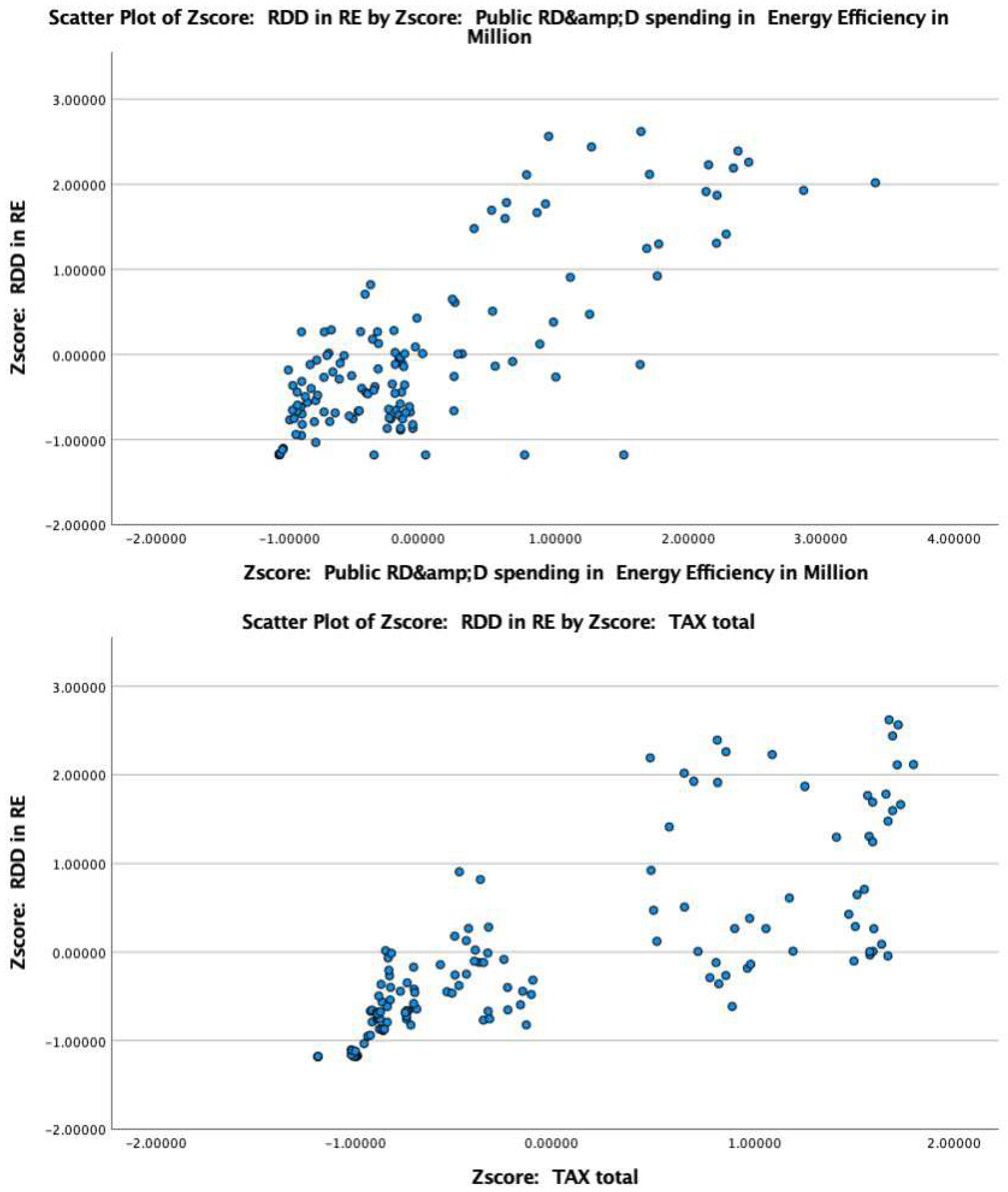
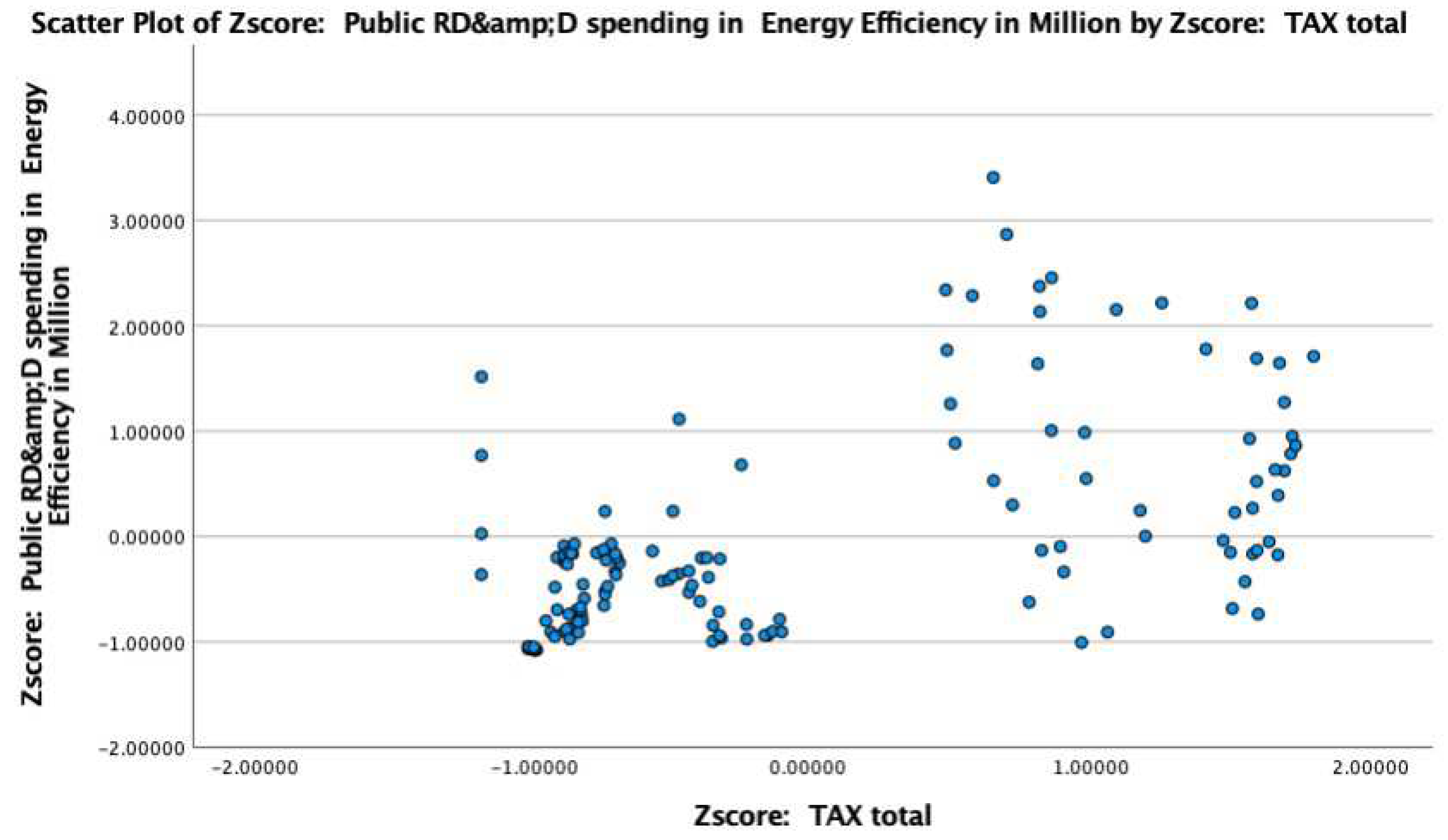


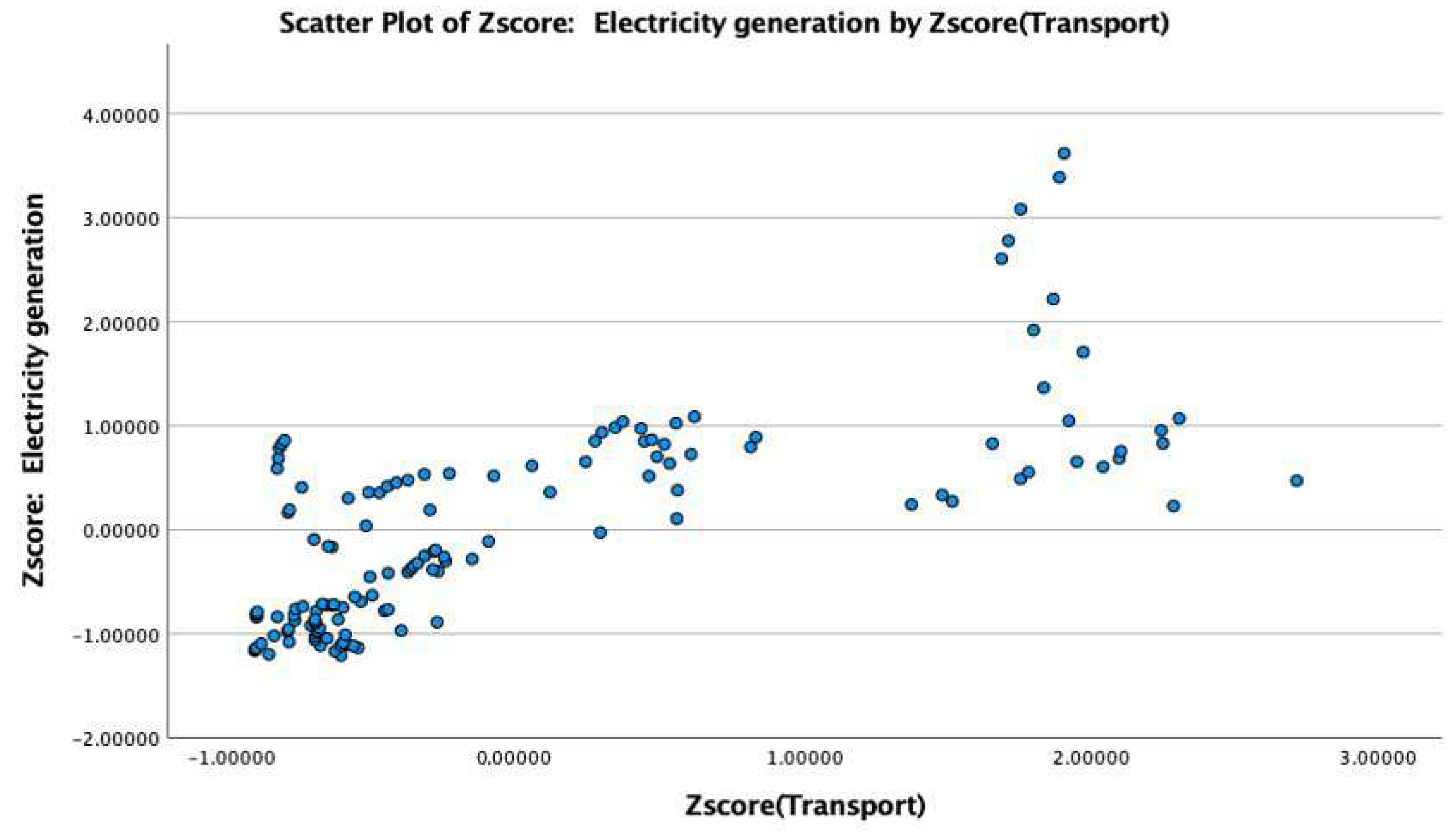
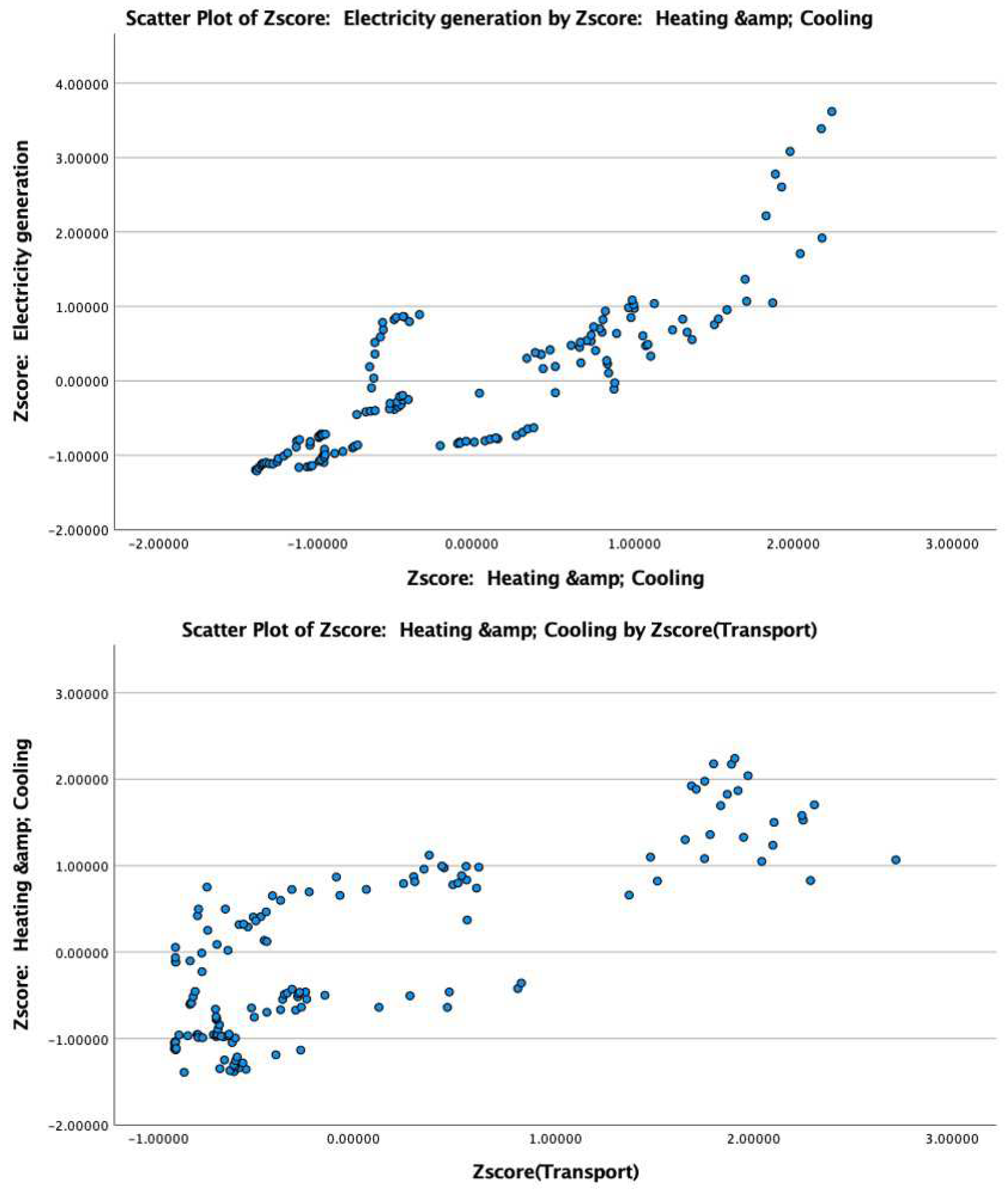
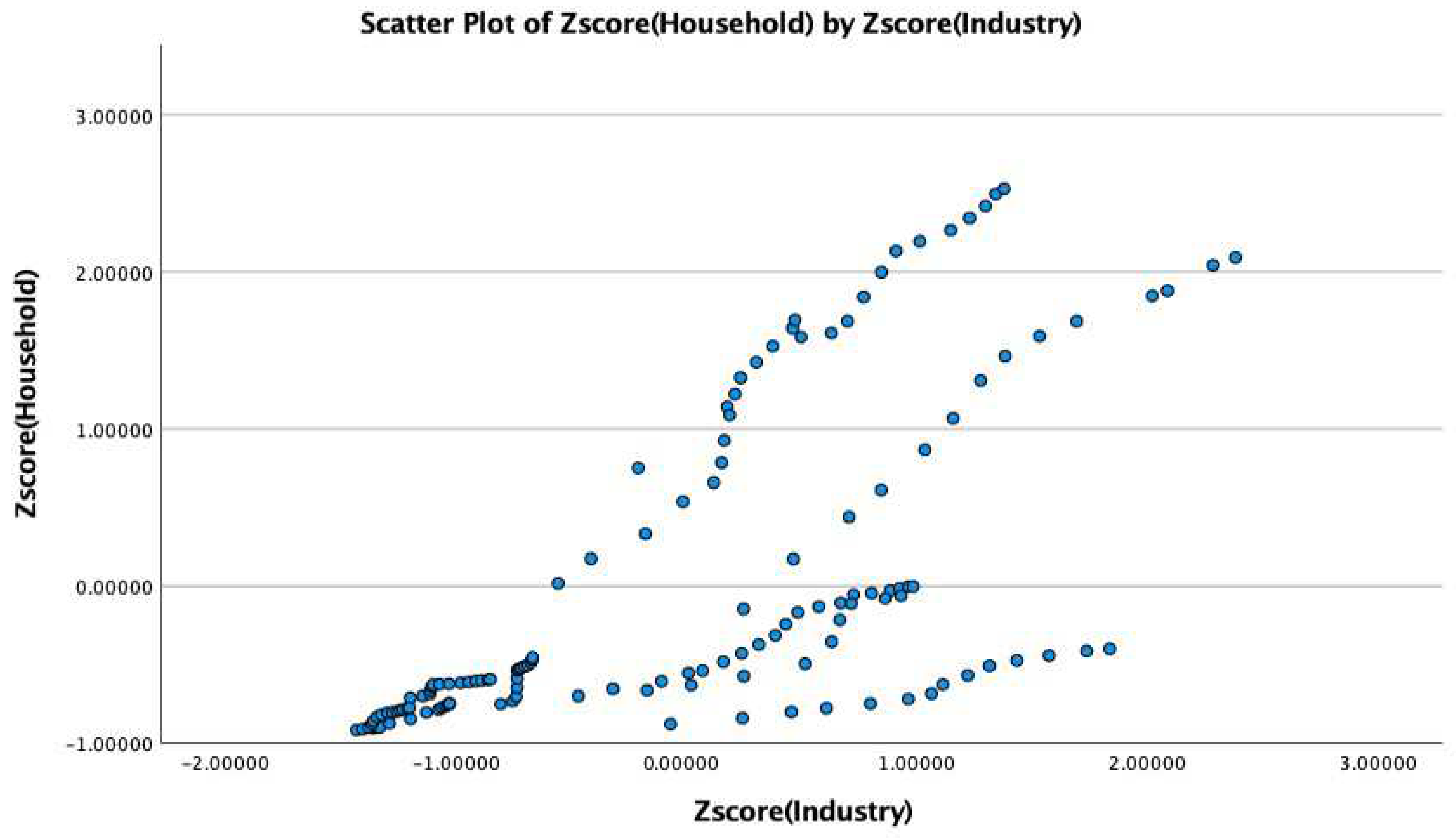

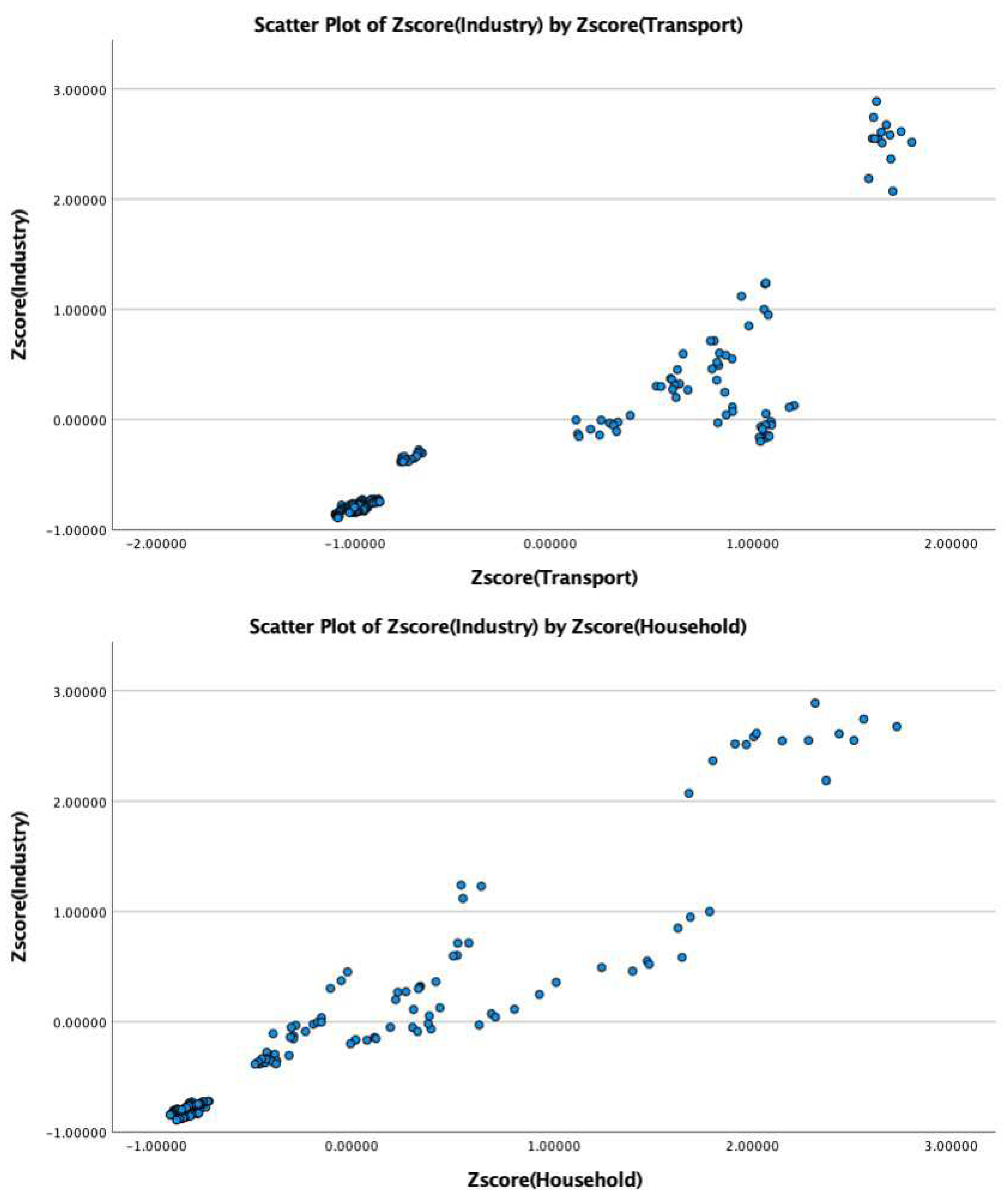

| Cronbach’s Alpha = 0.872 | ||||
|---|---|---|---|---|
| Correlations of Sub-Indicators in Supportive Policies of Decarbonization | RDD in RE | RDD in EE | Total Energy Tax | |
| RDD in RE | Pearson Correlation | 1 | 0.775 | 0.761 |
| Sig. (2-tailed) | 0.000 | 0.000 | ||
| N | 136 | 136 | 136 | |
| RDD in EE | Pearson Correlation | 0.775 | 1 | 0.547 |
| Sig. (2-tailed) | 0.000 | 0.000 | ||
| N | 136 | 136 | 136 | |
| Total energy tax | Pearson Correlation | 0.761 | 0.547 | 1 |
| Sig. (2-tailed) | 0.000 | 0.000 | ||
| N | 136 | 136 | 140 | |
| Cronbach’s Alpha = 0.884 | ||||
|---|---|---|---|---|
| Correlations of Sub-Indicators in Transformation (Technology Development) | Building | Industry | Transport | |
| Building | Pearson Correlation | 1 | 0.738 | |
| Sig. (2-tailed) | 0.000 | 0.000 | ||
| N | 138 | 126 | 138 | |
| Industry | Pearson Correlation | 0.822 | 1 | |
| Sig. (2-tailed) | 0.000 | |||
| N | 126 | 127 | 126 | |
| Transport | Pearson Correlation | 0.738 | 0.598 | 1 |
| Sig. (2-tailed) | 0.000 | 0.000 | ||
| N | 138 | 126 | 138 | |
| Cronbach’s Alpha = 0.92 | ||||
|---|---|---|---|---|
| Correlations of Sub-Indicators | Electricity generation | Heating and Cooling | Transport | |
| Electricity generation | Pearson Correlation | 1 | 0.830 | 0.740 |
| Sig. (2-tailed) | 0.000 | 0.000 | ||
| N | 140 | 140 | 140 | |
| Heating and Cooling | Pearson Correlation | 0.830 | 1 | 0.800 |
| Sig. (2-tailed) | 0.000 | 0.000 | ||
| N | 140 | 140 | 140 | |
| Transport | Pearson Correlation | 0.740 | 0.800 | 1 |
| Sig. (2-tailed) | 0.000 | 0.000 | ||
| N | 140 | 140 | 140 | |
| Cronbach’s Alpha = 0.53 | ||||
|---|---|---|---|---|
| Correlations of Sub-Indicators | Household | Industry | Transport | |
| Household | Pearson Correlation | 1 | 0.667 | −0.153 |
| Sig. (2-tailed) | 0.000 | 0.070 | ||
| N | 140 | 140 | 140 | |
| Industry | Pearson Correlation | 0.667 | 1 | 0.308 |
| Sig. (2-tailed) | 0.000 | 0.000 | ||
| N | 140 | 140 | 140 | |
| Transport | Pearson Correlation | −0.153 | 0.308 | 1 |
| Sig. (2-tailed) | 0.070 | 0.000 | ||
| N | 140 | 140 | 140 | |
| Cronbach’s Alpha = 0.96 | ||||
|---|---|---|---|---|
| Correlations of Sub-Indicators | Household | Industry | Transport | |
| Household | Pearson Correlation | 1 | 0.946 | 0.897 |
| Sig. (2-tailed) | 0.000 | 0.000 | ||
| N | 140 | 140 | 140 | |
| Industry | Pearson Correlation | 0.946 | 1 | 0.856 |
| Sig. (2-tailed) | 0.000 | 0.000 | ||
| N | 140 | 140 | 140 | |
| Transport | Pearson Correlation | 0.897 | 0.856 | 1 |
| Sig. (2-tailed) | 0.000 | 0.000 | ||
| N | 140 | 140 | 140 | |
Disclaimer/Publisher’s Note: The statements, opinions and data contained in all publications are solely those of the individual author(s) and contributor(s) and not of MDPI and/or the editor(s). MDPI and/or the editor(s) disclaim responsibility for any injury to people or property resulting from any ideas, methods, instructions or products referred to in the content. |
© 2023 by the authors. Licensee MDPI, Basel, Switzerland. This article is an open access article distributed under the terms and conditions of the Creative Commons Attribution (CC BY) license (https://creativecommons.org/licenses/by/4.0/).
Share and Cite
Mohammadi, N.; Mostofi, H.; Dienel, H.-L. Policy Chain of Energy Transition from Economic and Innovative Perspectives: Conceptual Framework and Consistency Analysis. Sustainability 2023, 15, 12693. https://doi.org/10.3390/su151712693
Mohammadi N, Mostofi H, Dienel H-L. Policy Chain of Energy Transition from Economic and Innovative Perspectives: Conceptual Framework and Consistency Analysis. Sustainability. 2023; 15(17):12693. https://doi.org/10.3390/su151712693
Chicago/Turabian StyleMohammadi, Naimeh, Hamid Mostofi, and Hans-Liudger Dienel. 2023. "Policy Chain of Energy Transition from Economic and Innovative Perspectives: Conceptual Framework and Consistency Analysis" Sustainability 15, no. 17: 12693. https://doi.org/10.3390/su151712693
APA StyleMohammadi, N., Mostofi, H., & Dienel, H.-L. (2023). Policy Chain of Energy Transition from Economic and Innovative Perspectives: Conceptual Framework and Consistency Analysis. Sustainability, 15(17), 12693. https://doi.org/10.3390/su151712693







